Analysis of Zener Diode and Switching Power Conversion in Electronics
VerifiedAdded on 2023/05/29
|34
|5259
|413
Report
AI Summary
This report delves into the characteristics and applications of Zener diodes and switching power conversion techniques. It begins with an introduction to Zener diodes, explaining their behavior in both forward and reverse bias conditions, including the Zener breakdown voltage and its significance in voltage regulation. The report outlines an experiment designed to analyze the Volt-Ampere properties of a Zener diode, determine its breakdown voltage, and calculate its dynamic and static resistance. It then transitions to switching power conversion, discussing the operation of buck, boost, and buck-boost converters, highlighting their advantages in terms of efficiency and space utilization. The report details the components of switching circuits and explores the use of these converters in various applications, including the generation of fixed or adjustable output voltages. The document also includes circuit diagrams, experimental procedures, and results, along with a graphical representation of the findings, providing a comprehensive overview of both Zener diodes and switching power conversion principles. The report concludes by emphasizing the importance of these technologies in modern power electronics.
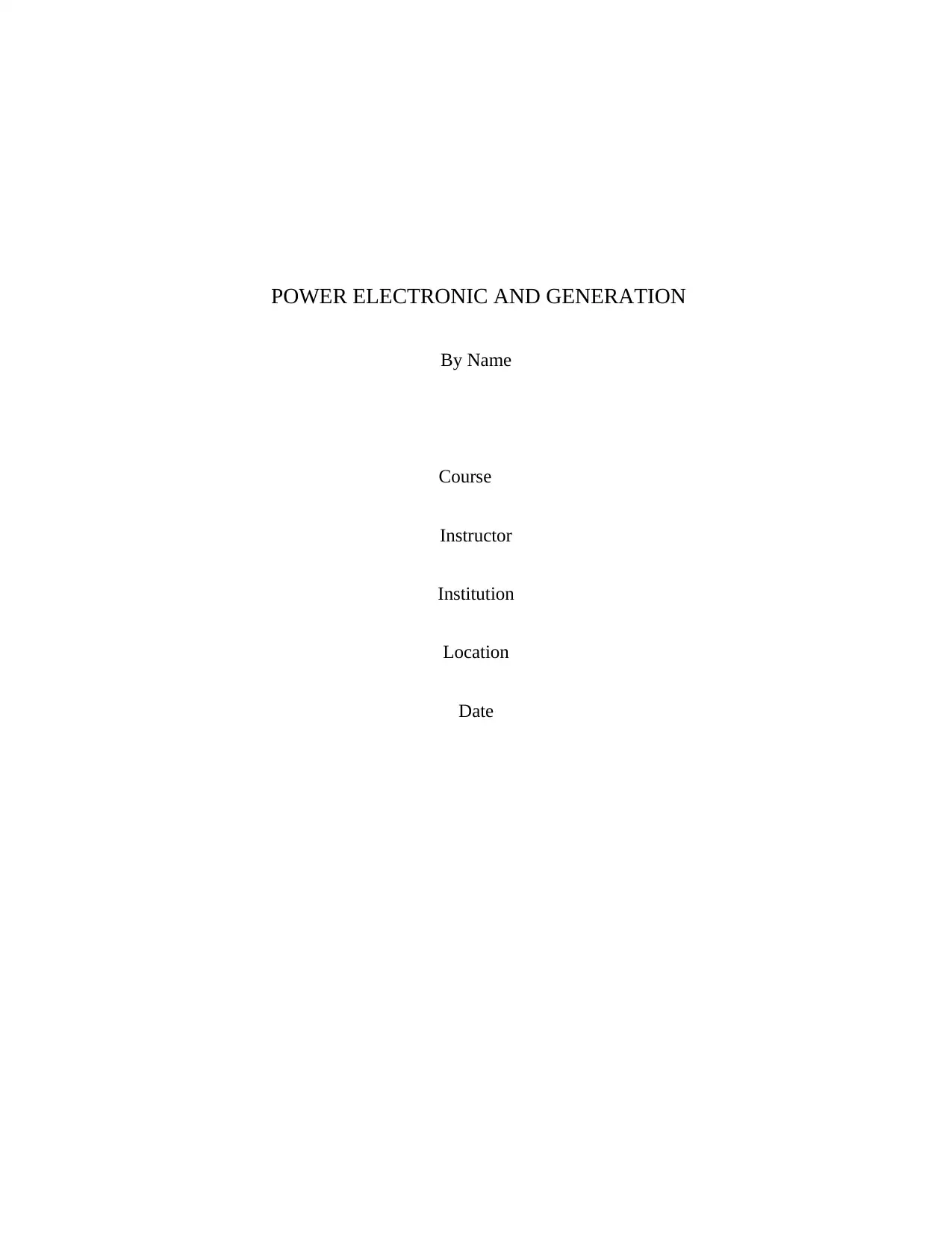
POWER ELECTRONIC AND GENERATION
By Name
Course
Instructor
Institution
Location
Date
By Name
Course
Instructor
Institution
Location
Date
Paraphrase This Document
Need a fresh take? Get an instant paraphrase of this document with our AI Paraphraser
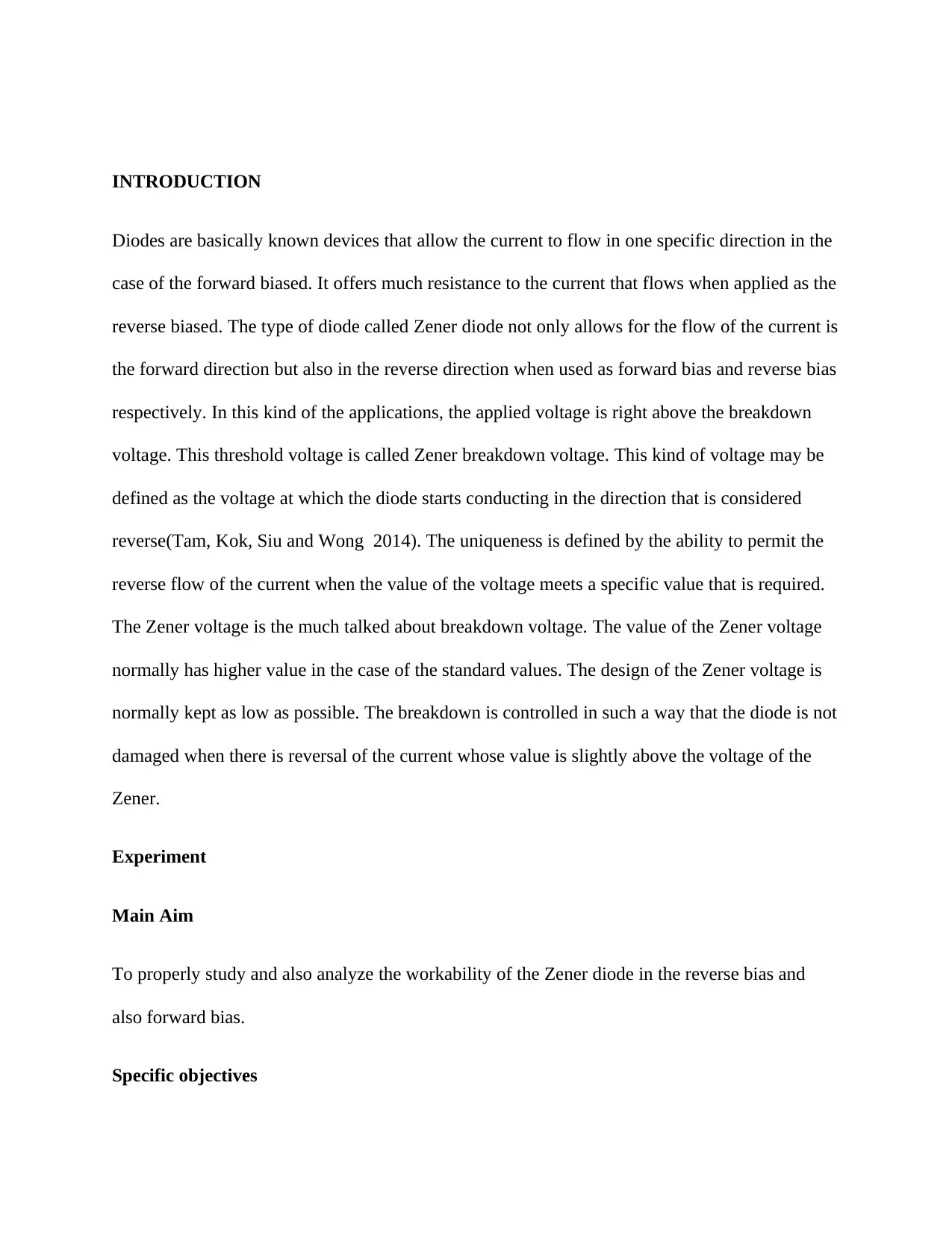
INTRODUCTION
Diodes are basically known devices that allow the current to flow in one specific direction in the
case of the forward biased. It offers much resistance to the current that flows when applied as the
reverse biased. The type of diode called Zener diode not only allows for the flow of the current is
the forward direction but also in the reverse direction when used as forward bias and reverse bias
respectively. In this kind of the applications, the applied voltage is right above the breakdown
voltage. This threshold voltage is called Zener breakdown voltage. This kind of voltage may be
defined as the voltage at which the diode starts conducting in the direction that is considered
reverse(Tam, Kok, Siu and Wong 2014). The uniqueness is defined by the ability to permit the
reverse flow of the current when the value of the voltage meets a specific value that is required.
The Zener voltage is the much talked about breakdown voltage. The value of the Zener voltage
normally has higher value in the case of the standard values. The design of the Zener voltage is
normally kept as low as possible. The breakdown is controlled in such a way that the diode is not
damaged when there is reversal of the current whose value is slightly above the voltage of the
Zener.
Experiment
Main Aim
To properly study and also analyze the workability of the Zener diode in the reverse bias and
also forward bias.
Specific objectives
Diodes are basically known devices that allow the current to flow in one specific direction in the
case of the forward biased. It offers much resistance to the current that flows when applied as the
reverse biased. The type of diode called Zener diode not only allows for the flow of the current is
the forward direction but also in the reverse direction when used as forward bias and reverse bias
respectively. In this kind of the applications, the applied voltage is right above the breakdown
voltage. This threshold voltage is called Zener breakdown voltage. This kind of voltage may be
defined as the voltage at which the diode starts conducting in the direction that is considered
reverse(Tam, Kok, Siu and Wong 2014). The uniqueness is defined by the ability to permit the
reverse flow of the current when the value of the voltage meets a specific value that is required.
The Zener voltage is the much talked about breakdown voltage. The value of the Zener voltage
normally has higher value in the case of the standard values. The design of the Zener voltage is
normally kept as low as possible. The breakdown is controlled in such a way that the diode is not
damaged when there is reversal of the current whose value is slightly above the voltage of the
Zener.
Experiment
Main Aim
To properly study and also analyze the workability of the Zener diode in the reverse bias and
also forward bias.
Specific objectives

o Plotting of the Volt-Ampere properties of the Zener diode
o To evaluate the Zener breakdown voltage in the reverse biased situations
o Calculations of the dynamic and static resistance of the Zener diode in both the reverse
and forward conditions that is evident before and after the breakdown.
Required Components
Zener Diode (1N5232B)
RL= 1k , Rs = 100
Black Board and Jumper Wire
DZ = Zener diode,
VZ = VL, Vo = 5.6 V
Vin = 10 – 15 V, IL = 10 mA, RL=?
Equipment:
Number of S Name Amount
1 DC regulated power supply
dual type of capacity 0-30V
One
2 A digital Ammeter type of
capacity 0-200mA
Two
3 Voltmeter(digital) 0-20V One
4 Decade Resistance Box One
5 Wires for connection One
Specifications of the Zener Diode (1N5232B)
Voltage for the breakdown=5.2V
o To evaluate the Zener breakdown voltage in the reverse biased situations
o Calculations of the dynamic and static resistance of the Zener diode in both the reverse
and forward conditions that is evident before and after the breakdown.
Required Components
Zener Diode (1N5232B)
RL= 1k , Rs = 100
Black Board and Jumper Wire
DZ = Zener diode,
VZ = VL, Vo = 5.6 V
Vin = 10 – 15 V, IL = 10 mA, RL=?
Equipment:
Number of S Name Amount
1 DC regulated power supply
dual type of capacity 0-30V
One
2 A digital Ammeter type of
capacity 0-200mA
Two
3 Voltmeter(digital) 0-20V One
4 Decade Resistance Box One
5 Wires for connection One
Specifications of the Zener Diode (1N5232B)
Voltage for the breakdown=5.2V
⊘ This is a preview!⊘
Do you want full access?
Subscribe today to unlock all pages.

Trusted by 1+ million students worldwide
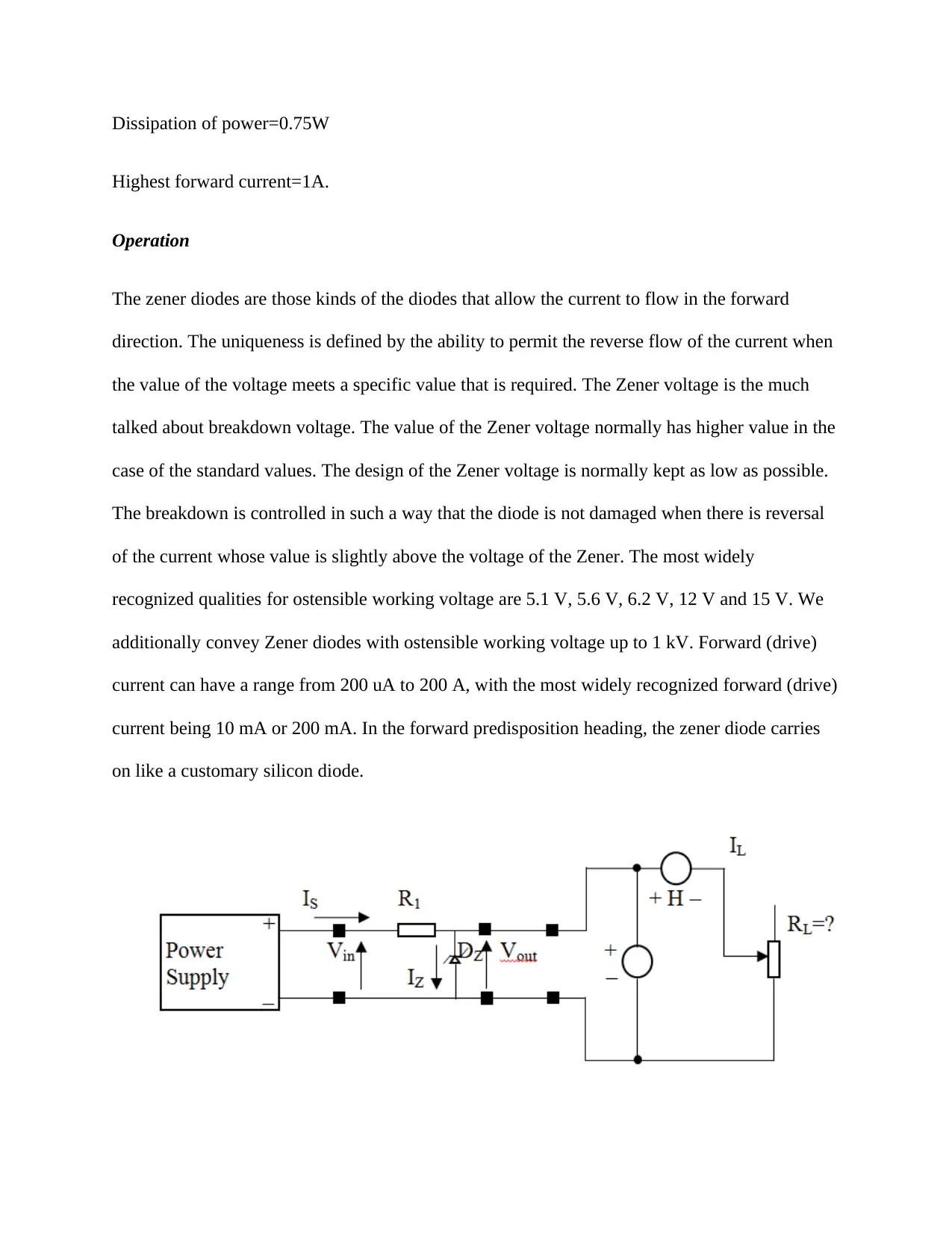
Dissipation of power=0.75W
Highest forward current=1A.
Operation
The zener diodes are those kinds of the diodes that allow the current to flow in the forward
direction. The uniqueness is defined by the ability to permit the reverse flow of the current when
the value of the voltage meets a specific value that is required. The Zener voltage is the much
talked about breakdown voltage. The value of the Zener voltage normally has higher value in the
case of the standard values. The design of the Zener voltage is normally kept as low as possible.
The breakdown is controlled in such a way that the diode is not damaged when there is reversal
of the current whose value is slightly above the voltage of the Zener. The most widely
recognized qualities for ostensible working voltage are 5.1 V, 5.6 V, 6.2 V, 12 V and 15 V. We
additionally convey Zener diodes with ostensible working voltage up to 1 kV. Forward (drive)
current can have a range from 200 uA to 200 A, with the most widely recognized forward (drive)
current being 10 mA or 200 mA. In the forward predisposition heading, the zener diode carries
on like a customary silicon diode.
Highest forward current=1A.
Operation
The zener diodes are those kinds of the diodes that allow the current to flow in the forward
direction. The uniqueness is defined by the ability to permit the reverse flow of the current when
the value of the voltage meets a specific value that is required. The Zener voltage is the much
talked about breakdown voltage. The value of the Zener voltage normally has higher value in the
case of the standard values. The design of the Zener voltage is normally kept as low as possible.
The breakdown is controlled in such a way that the diode is not damaged when there is reversal
of the current whose value is slightly above the voltage of the Zener. The most widely
recognized qualities for ostensible working voltage are 5.1 V, 5.6 V, 6.2 V, 12 V and 15 V. We
additionally convey Zener diodes with ostensible working voltage up to 1 kV. Forward (drive)
current can have a range from 200 uA to 200 A, with the most widely recognized forward (drive)
current being 10 mA or 200 mA. In the forward predisposition heading, the zener diode carries
on like a customary silicon diode.
Paraphrase This Document
Need a fresh take? Get an instant paraphrase of this document with our AI Paraphraser
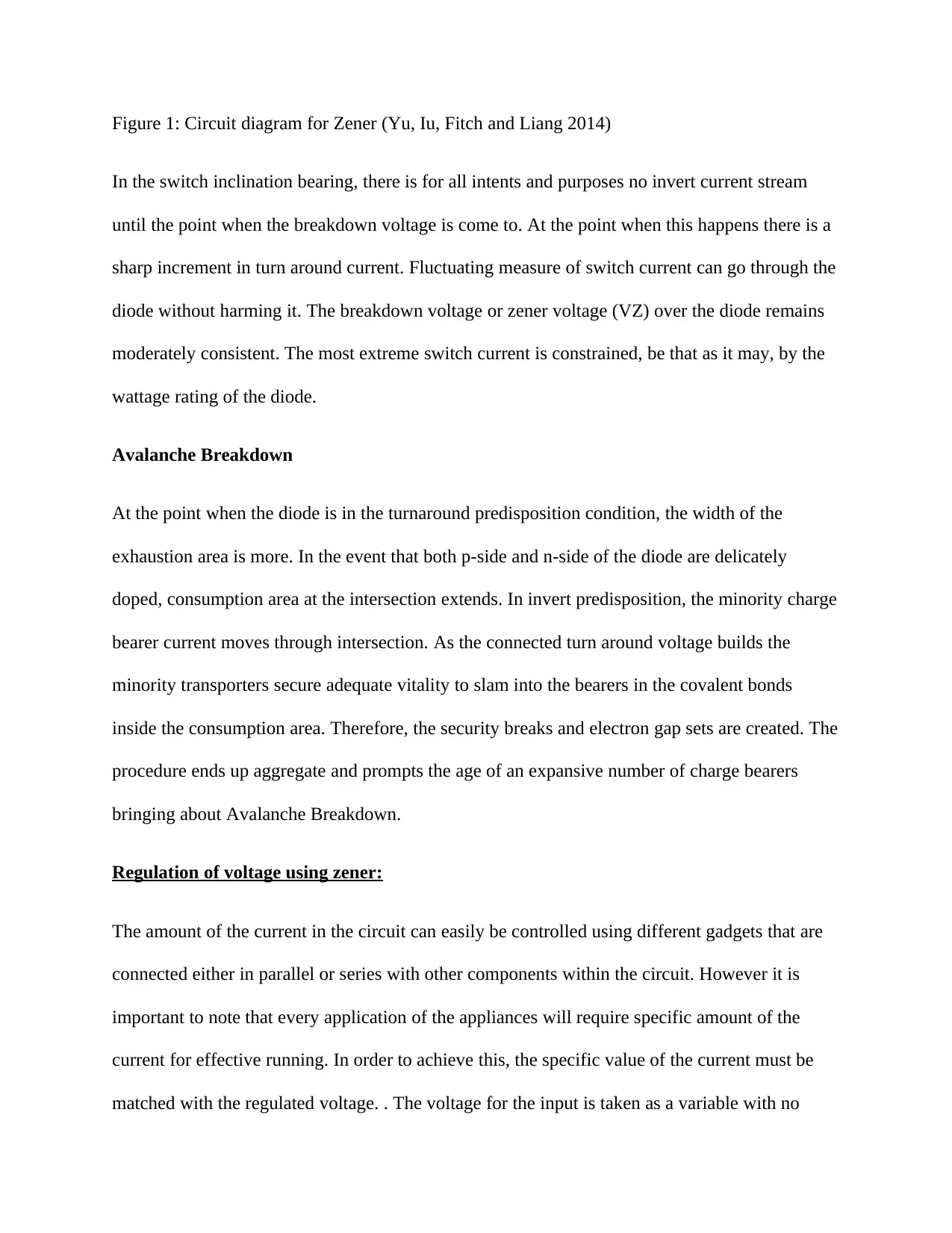
Figure 1: Circuit diagram for Zener (Yu, Iu, Fitch and Liang 2014)
In the switch inclination bearing, there is for all intents and purposes no invert current stream
until the point when the breakdown voltage is come to. At the point when this happens there is a
sharp increment in turn around current. Fluctuating measure of switch current can go through the
diode without harming it. The breakdown voltage or zener voltage (VZ) over the diode remains
moderately consistent. The most extreme switch current is constrained, be that as it may, by the
wattage rating of the diode.
Avalanche Breakdown
At the point when the diode is in the turnaround predisposition condition, the width of the
exhaustion area is more. In the event that both p-side and n-side of the diode are delicately
doped, consumption area at the intersection extends. In invert predisposition, the minority charge
bearer current moves through intersection. As the connected turn around voltage builds the
minority transporters secure adequate vitality to slam into the bearers in the covalent bonds
inside the consumption area. Therefore, the security breaks and electron gap sets are created. The
procedure ends up aggregate and prompts the age of an expansive number of charge bearers
bringing about Avalanche Breakdown.
Regulation of voltage using zener:
The amount of the current in the circuit can easily be controlled using different gadgets that are
connected either in parallel or series with other components within the circuit. However it is
important to note that every application of the appliances will require specific amount of the
current for effective running. In order to achieve this, the specific value of the current must be
matched with the regulated voltage. . The voltage for the input is taken as a variable with no
In the switch inclination bearing, there is for all intents and purposes no invert current stream
until the point when the breakdown voltage is come to. At the point when this happens there is a
sharp increment in turn around current. Fluctuating measure of switch current can go through the
diode without harming it. The breakdown voltage or zener voltage (VZ) over the diode remains
moderately consistent. The most extreme switch current is constrained, be that as it may, by the
wattage rating of the diode.
Avalanche Breakdown
At the point when the diode is in the turnaround predisposition condition, the width of the
exhaustion area is more. In the event that both p-side and n-side of the diode are delicately
doped, consumption area at the intersection extends. In invert predisposition, the minority charge
bearer current moves through intersection. As the connected turn around voltage builds the
minority transporters secure adequate vitality to slam into the bearers in the covalent bonds
inside the consumption area. Therefore, the security breaks and electron gap sets are created. The
procedure ends up aggregate and prompts the age of an expansive number of charge bearers
bringing about Avalanche Breakdown.
Regulation of voltage using zener:
The amount of the current in the circuit can easily be controlled using different gadgets that are
connected either in parallel or series with other components within the circuit. However it is
important to note that every application of the appliances will require specific amount of the
current for effective running. In order to achieve this, the specific value of the current must be
matched with the regulated voltage. . The voltage for the input is taken as a variable with no
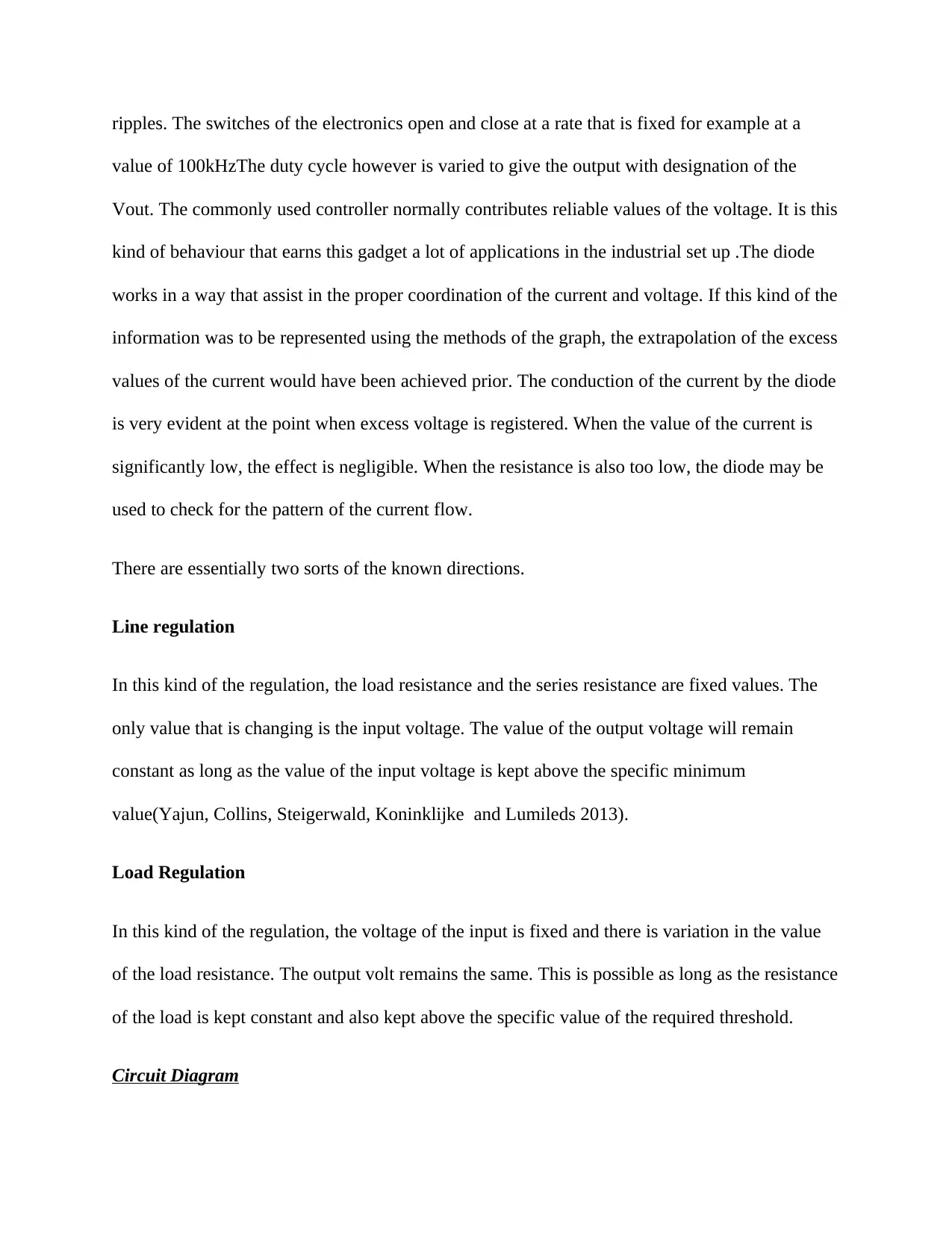
ripples. The switches of the electronics open and close at a rate that is fixed for example at a
value of 100kHzThe duty cycle however is varied to give the output with designation of the
Vout. The commonly used controller normally contributes reliable values of the voltage. It is this
kind of behaviour that earns this gadget a lot of applications in the industrial set up .The diode
works in a way that assist in the proper coordination of the current and voltage. If this kind of the
information was to be represented using the methods of the graph, the extrapolation of the excess
values of the current would have been achieved prior. The conduction of the current by the diode
is very evident at the point when excess voltage is registered. When the value of the current is
significantly low, the effect is negligible. When the resistance is also too low, the diode may be
used to check for the pattern of the current flow.
There are essentially two sorts of the known directions.
Line regulation
In this kind of the regulation, the load resistance and the series resistance are fixed values. The
only value that is changing is the input voltage. The value of the output voltage will remain
constant as long as the value of the input voltage is kept above the specific minimum
value(Yajun, Collins, Steigerwald, Koninklijke and Lumileds 2013).
Load Regulation
In this kind of the regulation, the voltage of the input is fixed and there is variation in the value
of the load resistance. The output volt remains the same. This is possible as long as the resistance
of the load is kept constant and also kept above the specific value of the required threshold.
Circuit Diagram
value of 100kHzThe duty cycle however is varied to give the output with designation of the
Vout. The commonly used controller normally contributes reliable values of the voltage. It is this
kind of behaviour that earns this gadget a lot of applications in the industrial set up .The diode
works in a way that assist in the proper coordination of the current and voltage. If this kind of the
information was to be represented using the methods of the graph, the extrapolation of the excess
values of the current would have been achieved prior. The conduction of the current by the diode
is very evident at the point when excess voltage is registered. When the value of the current is
significantly low, the effect is negligible. When the resistance is also too low, the diode may be
used to check for the pattern of the current flow.
There are essentially two sorts of the known directions.
Line regulation
In this kind of the regulation, the load resistance and the series resistance are fixed values. The
only value that is changing is the input voltage. The value of the output voltage will remain
constant as long as the value of the input voltage is kept above the specific minimum
value(Yajun, Collins, Steigerwald, Koninklijke and Lumileds 2013).
Load Regulation
In this kind of the regulation, the voltage of the input is fixed and there is variation in the value
of the load resistance. The output volt remains the same. This is possible as long as the resistance
of the load is kept constant and also kept above the specific value of the required threshold.
Circuit Diagram
⊘ This is a preview!⊘
Do you want full access?
Subscribe today to unlock all pages.

Trusted by 1+ million students worldwide

Condition of Forward bias
Figure 2: Condition of Forward bias
Illustrative circuit
Figure 3: Condition of illustrative circuit
A diode used in the regulation of the line within the circuit.
Figure 2: Condition of Forward bias
Illustrative circuit
Figure 3: Condition of illustrative circuit
A diode used in the regulation of the line within the circuit.
Paraphrase This Document
Need a fresh take? Get an instant paraphrase of this document with our AI Paraphraser
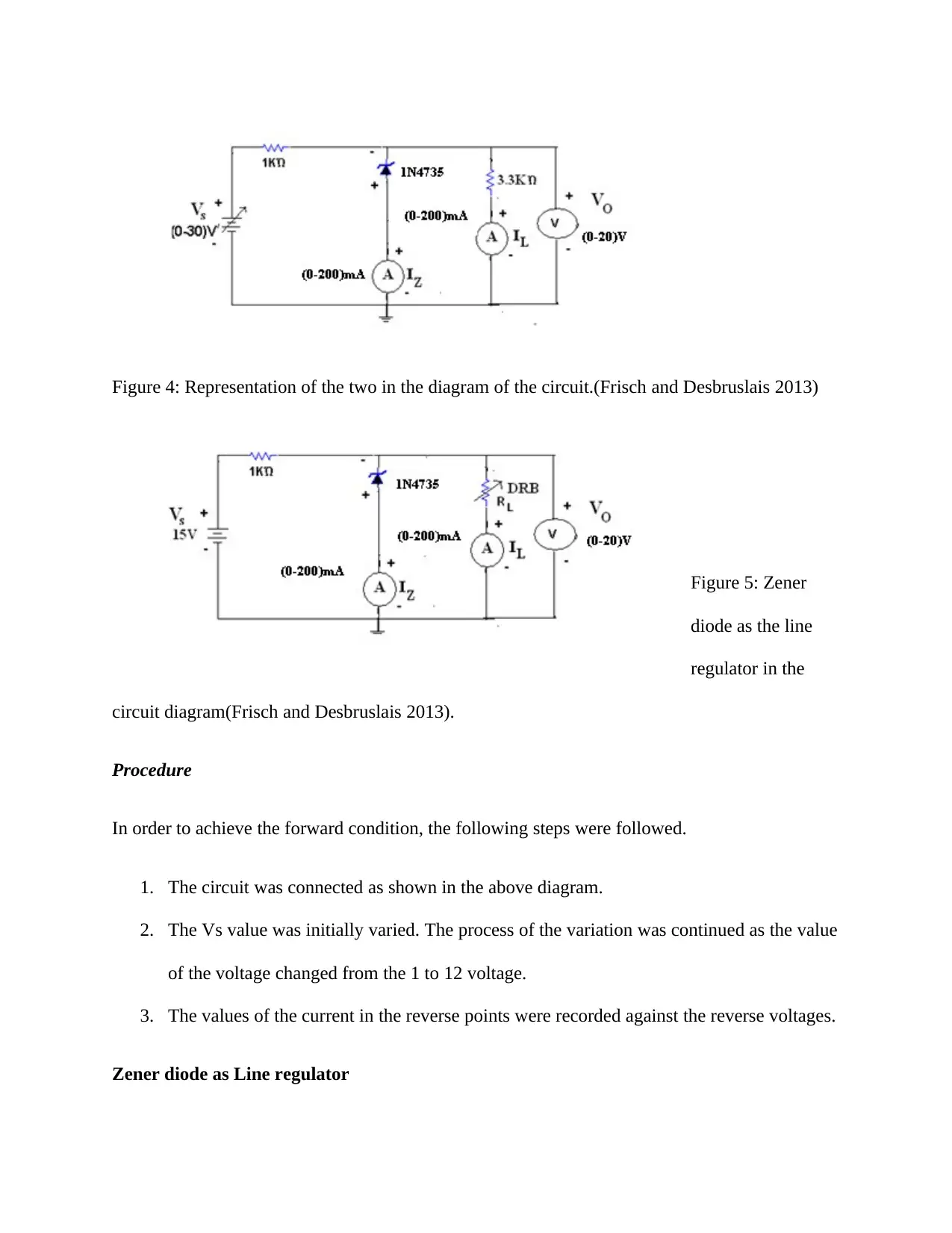
Figure 4: Representation of the two in the diagram of the circuit.(Frisch and Desbruslais 2013)
Figure 5: Zener
diode as the line
regulator in the
circuit diagram(Frisch and Desbruslais 2013).
Procedure
In order to achieve the forward condition, the following steps were followed.
1. The circuit was connected as shown in the above diagram.
2. The Vs value was initially varied. The process of the variation was continued as the value
of the voltage changed from the 1 to 12 voltage.
3. The values of the current in the reverse points were recorded against the reverse voltages.
Zener diode as Line regulator
Figure 5: Zener
diode as the line
regulator in the
circuit diagram(Frisch and Desbruslais 2013).
Procedure
In order to achieve the forward condition, the following steps were followed.
1. The circuit was connected as shown in the above diagram.
2. The Vs value was initially varied. The process of the variation was continued as the value
of the voltage changed from the 1 to 12 voltage.
3. The values of the current in the reverse points were recorded against the reverse voltages.
Zener diode as Line regulator
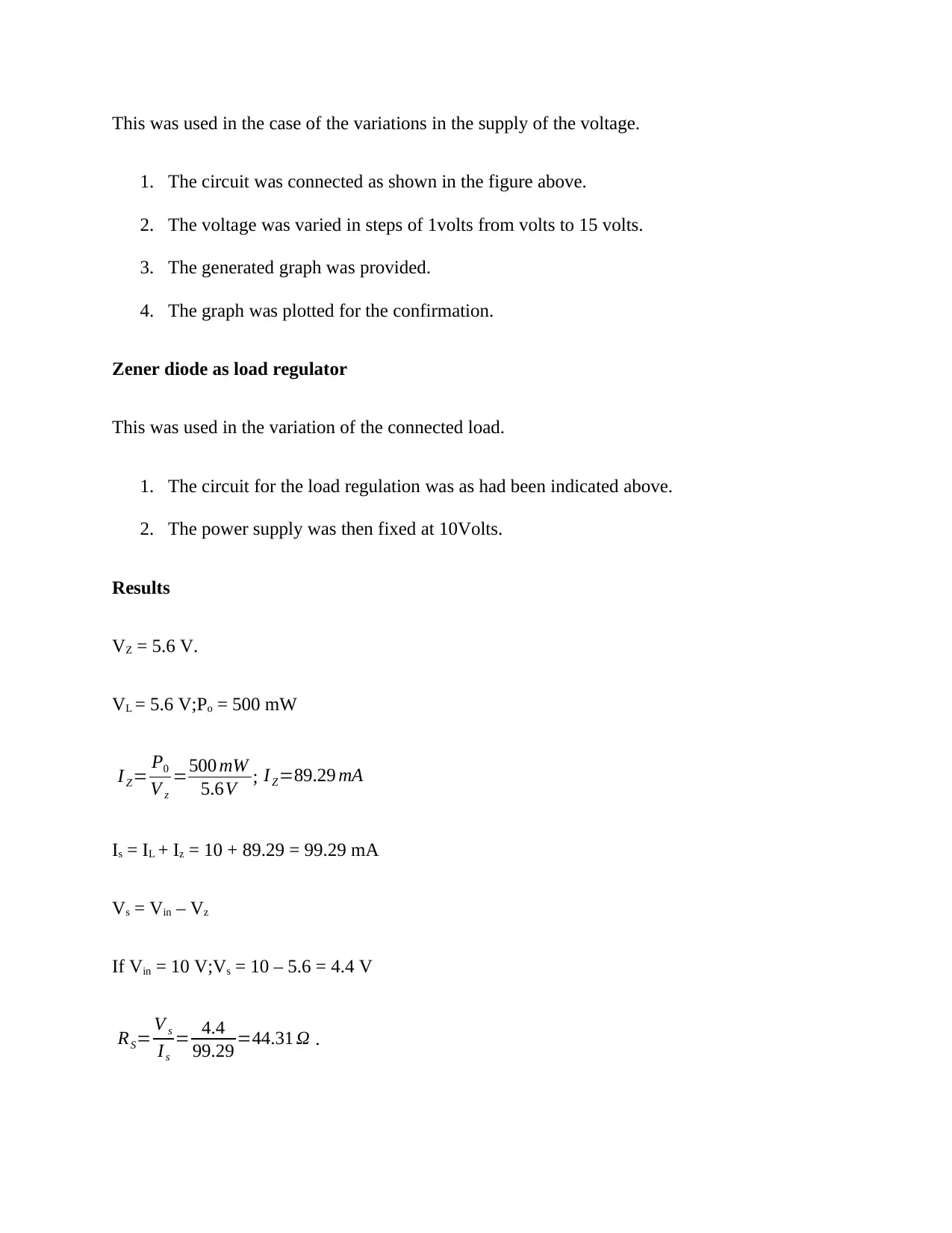
This was used in the case of the variations in the supply of the voltage.
1. The circuit was connected as shown in the figure above.
2. The voltage was varied in steps of 1volts from volts to 15 volts.
3. The generated graph was provided.
4. The graph was plotted for the confirmation.
Zener diode as load regulator
This was used in the variation of the connected load.
1. The circuit for the load regulation was as had been indicated above.
2. The power supply was then fixed at 10Volts.
Results
VZ = 5.6 V.
VL = 5.6 V;Po = 500 mW
I Z= P0
V z
=500 mW
5.6V ; I Z=89.29 mA
Is = IL + Iz = 10 + 89.29 = 99.29 mA
Vs = Vin – Vz
If Vin = 10 V;Vs = 10 – 5.6 = 4.4 V
RS= V s
Is
= 4.4
99.29 =44.31 Ω .
1. The circuit was connected as shown in the figure above.
2. The voltage was varied in steps of 1volts from volts to 15 volts.
3. The generated graph was provided.
4. The graph was plotted for the confirmation.
Zener diode as load regulator
This was used in the variation of the connected load.
1. The circuit for the load regulation was as had been indicated above.
2. The power supply was then fixed at 10Volts.
Results
VZ = 5.6 V.
VL = 5.6 V;Po = 500 mW
I Z= P0
V z
=500 mW
5.6V ; I Z=89.29 mA
Is = IL + Iz = 10 + 89.29 = 99.29 mA
Vs = Vin – Vz
If Vin = 10 V;Vs = 10 – 5.6 = 4.4 V
RS= V s
Is
= 4.4
99.29 =44.31 Ω .
⊘ This is a preview!⊘
Do you want full access?
Subscribe today to unlock all pages.

Trusted by 1+ million students worldwide
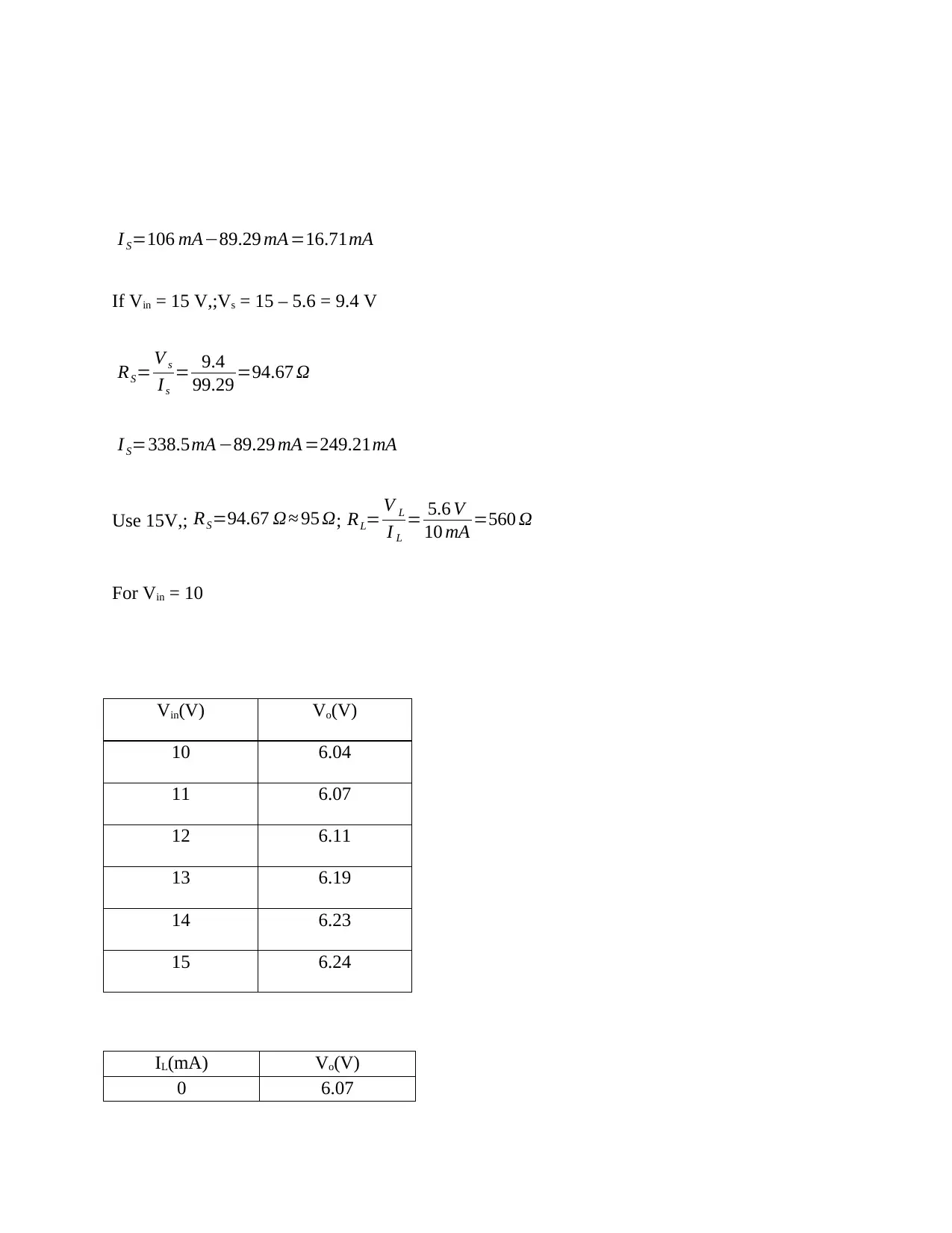
I S=106 mA−89.29 mA =16.71mA
If Vin = 15 V,;Vs = 15 – 5.6 = 9.4 V
RS= V s
Is
= 9.4
99.29 =94.67 Ω
I S=338.5mA −89.29 mA =249.21mA
Use 15V,; RS=94.67 Ω≈ 95 Ω; RL= V L
I L
= 5.6 V
10 mA =560 Ω
For Vin = 10
Vin(V) Vo(V)
10 6.04
11 6.07
12 6.11
13 6.19
14 6.23
15 6.24
IL(mA) Vo(V)
0 6.07
If Vin = 15 V,;Vs = 15 – 5.6 = 9.4 V
RS= V s
Is
= 9.4
99.29 =94.67 Ω
I S=338.5mA −89.29 mA =249.21mA
Use 15V,; RS=94.67 Ω≈ 95 Ω; RL= V L
I L
= 5.6 V
10 mA =560 Ω
For Vin = 10
Vin(V) Vo(V)
10 6.04
11 6.07
12 6.11
13 6.19
14 6.23
15 6.24
IL(mA) Vo(V)
0 6.07
Paraphrase This Document
Need a fresh take? Get an instant paraphrase of this document with our AI Paraphraser

15 6.05
20 6.01
30 5.99
40 5.96
50 5.92
60 5.80
70 5.35
80 4.56
90 3.98
100 3.45
105 2.12
For Vin = 15
Vin(V) Vo(V)
10 6.04
11 6.07
12 6.11
13 6.19
14 6.23
15 6.24
IL(mA) Vo(V)
0 6.27
15 6.24
20 6.21
30 6.18
40 6.15
50 6.10
60 6.04
70 6.01
80 5.98
90 5.34
100 2.56
105 0.65
20 6.01
30 5.99
40 5.96
50 5.92
60 5.80
70 5.35
80 4.56
90 3.98
100 3.45
105 2.12
For Vin = 15
Vin(V) Vo(V)
10 6.04
11 6.07
12 6.11
13 6.19
14 6.23
15 6.24
IL(mA) Vo(V)
0 6.27
15 6.24
20 6.21
30 6.18
40 6.15
50 6.10
60 6.04
70 6.01
80 5.98
90 5.34
100 2.56
105 0.65
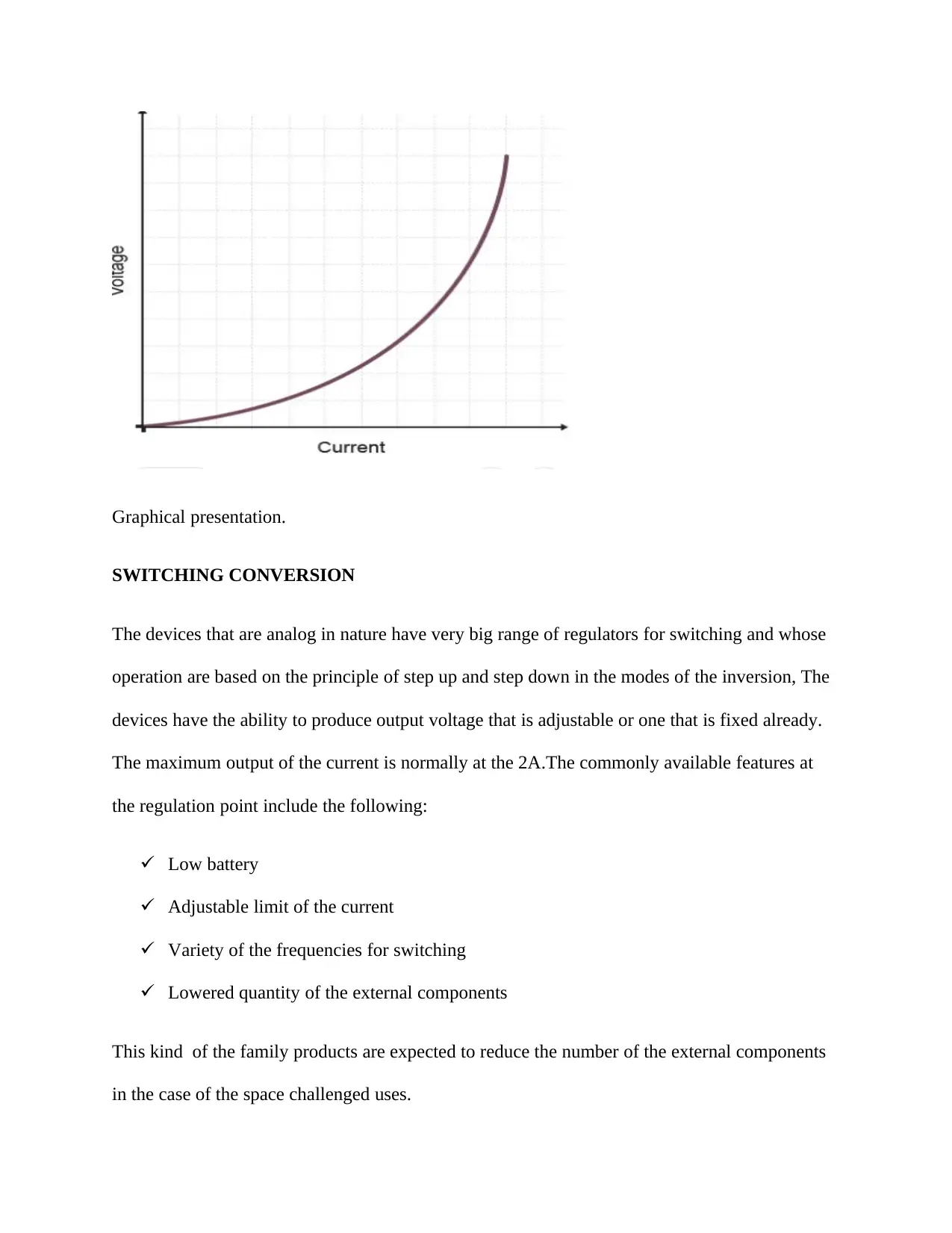
Graphical presentation.
SWITCHING CONVERSION
The devices that are analog in nature have very big range of regulators for switching and whose
operation are based on the principle of step up and step down in the modes of the inversion, The
devices have the ability to produce output voltage that is adjustable or one that is fixed already.
The maximum output of the current is normally at the 2A.The commonly available features at
the regulation point include the following:
Low battery
Adjustable limit of the current
Variety of the frequencies for switching
Lowered quantity of the external components
This kind of the family products are expected to reduce the number of the external components
in the case of the space challenged uses.
SWITCHING CONVERSION
The devices that are analog in nature have very big range of regulators for switching and whose
operation are based on the principle of step up and step down in the modes of the inversion, The
devices have the ability to produce output voltage that is adjustable or one that is fixed already.
The maximum output of the current is normally at the 2A.The commonly available features at
the regulation point include the following:
Low battery
Adjustable limit of the current
Variety of the frequencies for switching
Lowered quantity of the external components
This kind of the family products are expected to reduce the number of the external components
in the case of the space challenged uses.
⊘ This is a preview!⊘
Do you want full access?
Subscribe today to unlock all pages.

Trusted by 1+ million students worldwide
1 out of 34
Related Documents
Your All-in-One AI-Powered Toolkit for Academic Success.
+13062052269
info@desklib.com
Available 24*7 on WhatsApp / Email
![[object Object]](/_next/static/media/star-bottom.7253800d.svg)
Unlock your academic potential
Copyright © 2020–2025 A2Z Services. All Rights Reserved. Developed and managed by ZUCOL.





